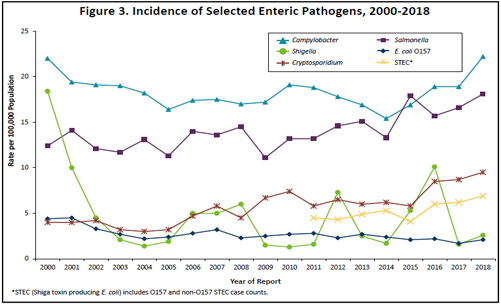Annual Summary of Disease Activity:
Disease Control Newsletter (DCN)
Related Topics
Contact Info
Escherichia coli O157 Infection and Hemolytic Uremic Syndrome (HUS), 2018
During 2018, 115 culture-confirmed cases of Escherichia coli O157 infection (2.06 per 100,000 population) were reported. The number of reported cases represents a 10% decrease from the median number of cases reported annually from 2008 to 2017 (median, 126.5 cases; range, 96 to 146). During 2018, 52 (45%) cases occurred in the metropolitan area. Eighty-five (74%) cases occurred during May through October. The median age of the cases was 27 years (range, 7 months to 88 years). Twelve percent of the cases were 4 years of age or younger. Thirty (26%) cases were hospitalized; the median hospital stay was 3 days (range, 1 to 47 days). Two cases, a 73-year-old female and a 46-year-old female, died.
In addition to the 115 culture-confirmed E. coli O157 cases, 270 cases of Shiga toxin-producing E. coli (STEC) infection were identified. Of those, culture-confirmation was not possible in 1, and therefore it is unknown if this was O157 or another serogroup. Among the remaining 269 cases, E. coli O103 was the serogroup for 68 (25%) cases, E. coli O111 for 45 (17%), E. coli O26 for 28 (10%), E. coli O145 for 15 (6%), E. coli O121 for 10 (4%), and E. coli O45 for 5 (2%). The median age of the non-O157 STEC cases was 28.5 years (range, 4 months to 90 years). Forty-one (15%) cases were hospitalized; the median hospital stay was 2 days (range, 1 to 28 days). One case, a 63-year-old female, died.
Culture-independent tests (CIDTs) have become increasingly adopted by clinical laboratories for the detection of Shiga toxin in stool. Two hundred twenty-two patient specimens that were positive by a CIDT conducted at a clinical laboratory were not subsequently culture-confirmed, and therefore did not meet the surveillance case definition for inclusion in MDH case count totals.
Two E. coli O157 outbreaks were identified during 2018. Both outbreaks were due to foodborne transmission, and were part of national investigations. These outbreaks resulted in 14 laboratory-confirmed Minnesota cases, with 2 and 12 cases, respectively. In May, a national outbreak was associated with romaine lettuce. Twelve cases were identified in Minnesota. Three cases developed hemolytic uremic syndrome (HUS), and 2 cases died. In October, a national outbreak was associated with chicken salad. Two laboratory-confirmed cases were identified in Minnesota. Neither case developed HUS or died.
Three non-O157 STEC outbreaks were identified during 2018. One outbreak was due to person-toperson transmission, one was due to waterborne transmission, and one was due to animal contact. An outbreak of E. coli O111 infections was associated with a petting zoo at a campground. Five laboratory-confirmed cases were identified. Two cases developed HUS but none died. An outbreak of both E. coli O121 and Cryptosporidium infections was associated with a campground. Seventy-nine cases were identified, including 2 laboratoryconfirmed cases of E. coli O121 infections and 5 laboratory-confirmed cases of Cryptosporidium infections. No cases developed HUS or died. An outbreak of E. coli O103 infections associated with person-to-person transmission occurred at a childcare facility in Martin County. Five cases, including 1 laboratory-confirmed, were identified. No cases developed HUS or died.
Hemolytic Uremic Syndrome (HUS)
In 2018, 11 HUS cases were reported. The number of reported cases is similar to the median number of cases reported annually from 2008 to 2017 (median, 12.5 cases; range, 9 to 17). In 2018, the median age of HUS cases was 46 years (range, 1 year to 81 years); 4 of the 11 cases occurred in children less than 7 years of age. All 11 cases were hospitalized, with a median hospital stay of 9 days (range, 3 to 48 days). From 1997 through 2018, the overall case fatality rate among HUS cases was 5.5%. Nine of the 11 HUS cases reported in 2018 were post-diarrheal. E. coli O157:H7 was cultured from the stool of 8 (73%) cases, E. coli O111 was cultured from the stool of 2 (18%) cases, and E. coli O777 was isolated from the stool of 1 (9%) case. In 2018, there were 5 outbreak-associated HUS cases. All outbreak-associated HUS cases were hospitalized; the median hospital stay was 11 days (range, 3 to 47 days), and 1 died.

- For up to date information see:E. coli O157:H7 and HUS
- Full issue>> Annual Summary of Communicable Diseases Reported to the Minnesota Department of Health, 2018